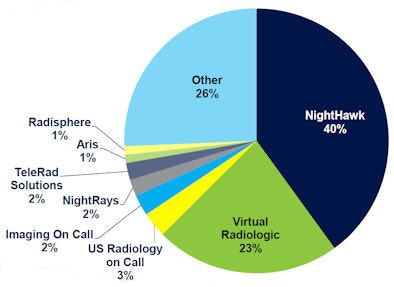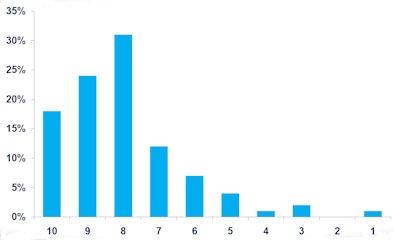
Radiology groups that use teleradiology tend to be loyal customers, reporting high levels of satisfaction and lasting relationships with their service provider, according to a new report from healthcare technology research and advisory firm CapSite.
The company surveyed 363 radiology groups in the U.S. and found that the majority of teleradiology users had been working with their teleradiology services provider for three or more years.
For the purposes of the report, CapSite defined teleradiology as the use of "an outside vendor that reads a portion of the facility's radiology studies on a regular basis."
Of the 363 groups participating in the survey, 42% had 16 or more radiologists, 15% had 11 to 15 radiologists, 19% had six to 10 radiologists, and 24% had one to five radiologists.
Sixty-three percent were currently using a teleradiology provider, while 37% were not.
 |
| Teleradiology market share. All images courtesy of CapSite. |
Customers tended to be satisfied with their current teleradiology provider, CapSite said.
 |
| Customer satisfaction ratings of current teleradiology service provider. |
Approximately two-thirds of teleradiology clients reported they had worked with their provider for more than three years, with around 20% partnering for two years.
In a somewhat surprising finding, nearly half of teleradiology users considered the most important quality measure for a teleradiology provider to be its use of highly qualified radiologists reading studies, CapSite said.
"We thought we would see a greater emphasis on turnaround time," said Bryan Fiekers, director of business development at CapSite.
Turnaround time (approximately 20%) came in third, however, behind a low miss rate (approximately 30%).
Only 31% of current teleradiology users said they plan to re-evaluate teleradiology services. Of those planning to re-evaluate, approximately 40% planned to do within six to 12 months, while around 30% were targeting a 13- to 18-month time frame. Approximately 23% planned to do so in less than six months.
In other findings, organizations that were not using teleradiology services weren't typically planning to adopt that new model, Fiekers said. Only 10% of nonteleradiology users reported that they planned to evaluate teleradiology services; 90% did not have plans.
Reasons for this stance varied, with 66% stating that their group had responsibility for all reads, 28% indicating that they are an academic institution and use residents for reads, and 6% noting other reasons.
For more information on the report, click here.




















